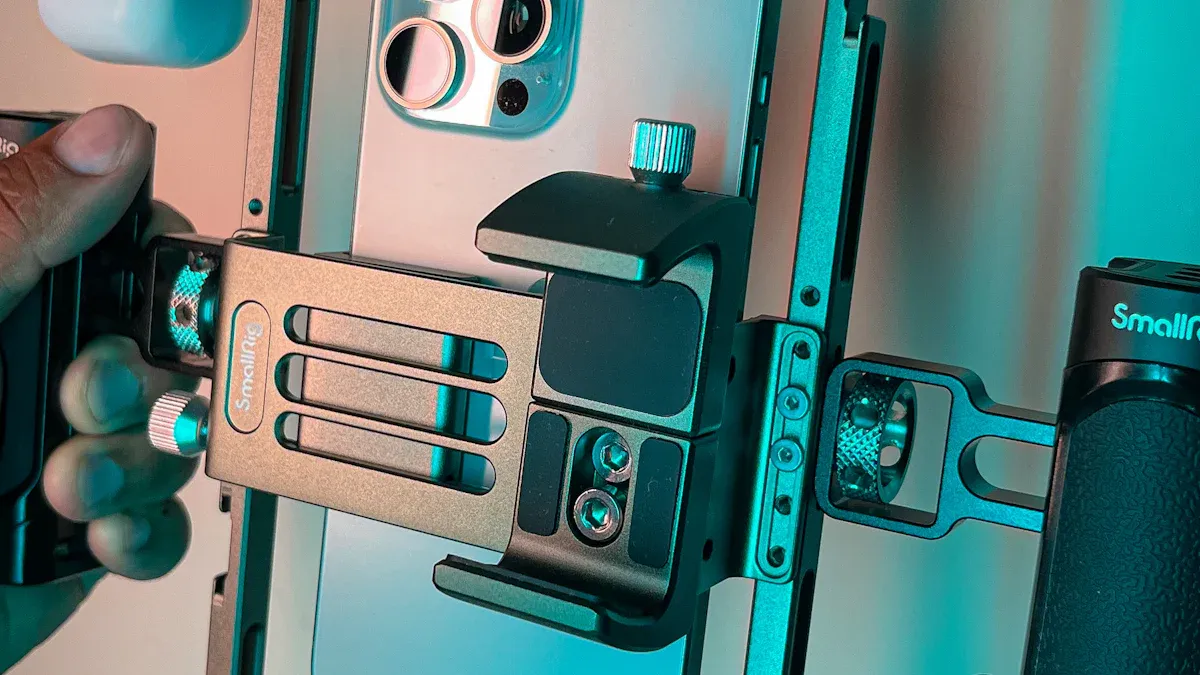For information about how Screenfluence can help your business with digital signage, please don’t hesitate to contact us by calling 1-844-772-7336 or emailing info@screenfluence.com.
Contact UsUnderstanding Digital Signage ROI
What Is Digital Signage ROI
Digital signage ROI refers to the return on investment you achieve from implementing a digital signage program. It measures the financial and non-financial benefits gained compared to the costs incurred. Businesses often define ROI by evaluating increased sales, improved customer engagement, or operational efficiencies. For example, digital signage can reduce perceived wait times by up to 35% and increase sales by an average of 31.8%. These metrics highlight how digital signage can deliver tangible and intangible returns.
To calculate ROI, you need to consider both direct and indirect benefits. Direct benefits include increased revenue or cost savings, while indirect benefits might involve enhanced brand awareness or better staff productivity. By understanding these factors, you can assess whether your digital signage program aligns with your business goals.
Why It’s Important to Measure Digital Signage ROI
Measuring digital signage ROI helps you determine the effectiveness of your investment. Without tracking results, you risk wasting resources on strategies that don’t deliver value. For instance, 70% of Americans recall seeing a digital video display in the past month, showing the potential reach of digital signage. However, to maximize this impact, you need clear objectives and measurable outcomes.
Tracking ROI also allows you to refine your digital signage program. If a campaign isn’t performing well, data can guide adjustments to improve results. Businesses that measure ROI often report benefits like increased sales, higher customer retention, and improved marketing strategies. By focusing on measurable outcomes, you ensure your investment drives meaningful results.
Common Challenges in Measuring ROI
Measuring digital signage ROI can be challenging due to several factors. One common obstacle is quantifying intangible benefits like brand awareness or customer satisfaction. These metrics are harder to measure but still crucial for evaluating success. Another challenge involves evolving technology and market trends, which require constant adaptation. For example, while digital signage displays have a lifespan of 4-6 years, their effectiveness depends on keeping content fresh and relevant.
Establishing clear objectives is another hurdle. Without defined goals, it’s difficult to track progress or measure success. Businesses also face challenges in aligning metrics with their overall strategy. To overcome these issues, focus on setting specific, measurable objectives and using tools like analytics software to track performance.
Setting Objectives and Identifying Key Metrics
How to Define Clear Objectives for Digital Signage
Defining clear objectives is the foundation of a successful digital signage program. You need to identify what you aim to achieve before launching your campaign. For instance, a retail business might focus on increasing sales by showcasing promotional offers and product highlights. In healthcare, digital signage can enhance patient experience by displaying wayfinding information or wait times. Educational institutions often use digital signage to improve communication by sharing event schedules, campus maps, and announcements.
Your objectives should align with your broader business goals. Whether you want to boost sales, enhance brand visibility, or improve customer experience, these goals will guide your content, placement, and technology choices. Clear objectives also help you measure digital signage performance effectively, ensuring your investment delivers the desired results.
Key Metrics to Measure Digital Signage ROI
To measure digital signage ROI, you need to track key performance indicators (KPIs) that align with your objectives. These metrics fall into three main categories:
Engagement Metrics (e.g., impressions, dwell time)
Engagement metrics help you understand how viewers interact with your displays. Metrics like dwell time and interaction rates reveal how effectively your content captures attention. For example, tracking the content engagement rate shows how well your message resonates with the audience.
Conversion Metrics (e.g., sales, leads)
Conversion metrics measure how well your digital signage campaign drives actions like purchases or lead generation. Metrics such as sales figures, conversion rates, and revenue per display provide insights into financial effectiveness. Combining these quantitative metrics with customer feedback offers a comprehensive evaluation.
Operational Metrics (e.g., cost savings, efficiency)
Operational metrics assess how your digital signage program improves efficiency. For instance, tracking cost savings or staff productivity highlights operational benefits. Metrics like average display uptime and cost per acquisition also demonstrate how well your system supports business operations.
Aligning Metrics with Business Goals
Aligning digital signage KPIs with your business goals ensures your program contributes to long-term success. Regularly review and update KPIs to maintain their relevance. For example, monitoring metrics like revenue per display and client retention rate helps track progress toward strategic objectives. Operational KPIs, such as maintaining average display uptime at 99%, directly impact customer satisfaction. Involving team members across departments fosters accountability and ensures alignment with organizational goals.
By focusing on advanced analytics and aligning metrics with your objectives, you can maximize the impact of your digital signage program. This approach ensures your investment drives measurable results and supports broader business strategies.
Methods to Measure Digital Signage ROI

Quantitative vs. Qualitative Approaches
When measuring digital signage ROI, you can use both quantitative and qualitative approaches. Each method provides unique insights into your digital signage program’s effectiveness.
- Quantitative methods focus on measurable data, such as sales figures, impressions, and engagement rates. These metrics help you track the financial impact of your digital signage campaign. For example, analytics tools can measure dwell time or the number of views to evaluate content performance.
- Qualitative methods emphasize customer experiences and perceptions. Surveys and interviews allow you to gather feedback on how viewers interact with your displays. This approach helps you understand user satisfaction and identify areas for improvement.
Combining these methods gives you a comprehensive view of your digital signage performance. While quantitative data highlights measurable outcomes, qualitative insights reveal the “why” behind the numbers.
Tools to Measure Digital Signage ROI
Several tools can help you track and analyze your digital signage program’s success:
- Digital Signage Analytics Software: These tools provide data on display performance, audience demographics, and engagement rates. They also track metrics like dwell time and conversion rates, offering valuable insights into your campaign’s effectiveness.
- Heatmaps: Heatmaps visualize viewer attention, showing which parts of your content attract the most interest. This tool helps you optimize content placement and design.
- Audience Measurement Tools: These tools collect demographic data, such as age and gender, to tailor content to specific audience segments. They also measure impressions and engagement rates to assess content effectiveness.
- Content Management Systems (CMS): CMS platforms track content performance metrics, including views and interactions, enabling you to refine your strategy.
Using these tools allows you to leverage advanced analytics to make data-driven decisions. For instance, tracking foot traffic data can help you allocate resources more effectively.
Real-World Examples of ROI Measurement
Businesses across industries have successfully measured digital signage ROI. Here are some examples:
| Business | ROI Metric | Description |
|---|---|---|
| Pearl Lemon | Reduced customer issue ticket numbers by 15% | Implemented TV dashboards to reduce complaints, leading to significant ROI. |
| Clean House | Grew their Instagram following by 15,800 new accounts | Developed a digital signage solution that enhanced brand engagement and social media presence. |
| Leroy Merlin | Saved 2x the time by using a simpler digital content publishing tool | Improved efficiency in content publishing across multiple locations, allowing teams to focus on other tasks. |
These examples demonstrate how businesses can achieve measurable results by aligning digital signage KPIs with their objectives.
Calculating Digital Signage ROI: A Step-by-Step Guide
The ROI Formula for Digital Signage
To calculate ROI for your digital signage program, use the standard formula:
ROI = (Total Benefits - Total Costs) / Total Costs x 100
This formula provides a percentage that represents the return on your investment. To apply it, you need to compile all costs, such as hardware, software, and operational expenses. Then, quantify the benefits, including increased sales, cost savings, or improved efficiency. For example, if your digital signage campaign generates $50,000 in benefits and costs $20,000, the ROI would be:
ROI = ($50,000 - $20,000) / $20,000 x 100 = 150%
This means your investment yielded a 150% return.
Breaking Down Costs and Investments
Hardware and Software Costs
Understanding the costs of hardware and software is crucial when calculating ROI. Hardware expenses include displays, media players, and installation equipment. For instance:
- Basic setups cost around $2,000, while advanced installations can exceed $10,000.
- Outdoor displays range from $3,000 to $10,000, with weatherproof enclosures adding $500 to $2,000.
Software costs cover tools for managing and scheduling content. These typically start at $11 per month but can increase for advanced features. Annual software updates and support fees range from $100 to $500 per screen.
| Cost Type | Description | Example Cost Range |
|---|---|---|
| Hardware Costs | Displays, media players, installation equipment | $2,000 to $10,000+ |
| Software Costs | Content management and scheduling tools | $11/month to several hundred/month |
Content Creation and Maintenance Costs
Content creation and maintenance also impact your investment. Professional design services cost $100 to $1,000 per project, depending on complexity. Monthly content creation tools range from $10 to $50. Maintenance costs include cleaning ($50–$100 annually per screen) and energy usage ($50–$300 annually). Hidden fees, like unexpected design revisions, can increase expenses, so plan accordingly.
Real-World Example: Retail Digital Signage ROI Calculation
Imagine a retail store investing in digital signage to boost sales. The initial investment includes $5,000 for hardware and $1,200 annually for software. Operational costs, such as energy and maintenance, total $500 per year. Over a year, the store sees a $15,000 increase in revenue due to improved customer engagement.
Using the formula:
ROI = ($15,000 - $6,700) / $6,700 x 100 = 124%
This calculation shows a 124% ROI, demonstrating the effectiveness of aligning digital signage KPIs with business goals.
Interpreting Results and Adjusting Strategies
Interpreting the results of your digital signage program is essential for improving its effectiveness. Start by analyzing the data you’ve collected. Look for patterns in metrics like engagement rates, conversion rates, and operational efficiency. For example, if engagement metrics show low dwell times, your content might not be capturing attention. Identifying these trends helps you pinpoint areas that need improvement.
Once you’ve identified gaps, adjust your strategy to address them. If your digital signage campaign isn’t driving conversions, consider testing new content formats or updating your messaging. Experiment with different visuals, calls-to-action, or display placements. A/B testing can help you determine what works best for your audience. Use the insights from these tests to refine your approach.
Regularly reviewing your results ensures your program stays aligned with your business goals. Set a schedule for performance evaluations, such as monthly or quarterly reviews. During these reviews, compare your current metrics to your initial objectives. If you’re not meeting your goals, reassess your strategy and make necessary changes. For instance, if operational metrics reveal high maintenance costs, explore more cost-effective hardware or software options.
Collaboration across teams can also improve your results. Share your findings with marketing, sales, and operations teams to gather diverse perspectives. This collaboration ensures your digital signage program supports broader organizational objectives. By continuously interpreting results and refining strategies, you can maximize the impact of your investment.
Pro Tip: Use analytics tools to automate data collection and visualization. This saves time and provides clear insights for decision-making.
Case Studies: Real-World Success Stories

Retail: Increasing Sales with Targeted Digital Signage
Retail businesses have successfully leveraged digital signage to boost sales and enhance customer engagement. For example, McDonald’s improved order accuracy and customer experience by integrating digital kiosks. Adidas used digital signage in pop-up stores to create buzz and engage shoppers. Sephora bridged online and offline retail, driving cross-channel sales, while Tesla utilized interactive displays in showrooms to educate and captivate customers.
| Retail Business | Impact of Digital Signage |
|---|---|
| McDonald’s | Improved order accuracy and customer experience with digital kiosks. |
| Adidas | Enhanced engagement and buzz in pop-up stores using digital signage display. |
| Sephora | Bridged online and offline retail, boosting cross-channel sales. |
| Tesla | Educated and engaged customers in showrooms with interactive digital displays. |
Dynamic digital signage captures attention more effectively than static images. High-definition screens can showcase products and promotions, while videos demonstrate product usage. A NYC fast food chain exemplifies this by using personalized, context-aware content and real-time analytics to create impactful customer interactions. These strategies highlight how retail digital signage ROI can be maximized through targeted campaigns.
Hospitality: Enhancing Guest Experience and Efficiency
Digital signage transforms the hospitality industry by improving guest experiences and operational efficiency. Interactive maps and directories help guests navigate large hotels, reducing confusion and enhancing comfort. Personalized content on digital screens promotes on-site amenities, encouraging guests to explore services like spas or restaurants. This not only increases revenue but also elevates guest satisfaction.
Pro Tip: Use digital signage to showcase local attractions and events. This engages guests with the community and enhances their stay.
Operational efficiency also improves with digital signage. Real-time updates reduce printing costs and environmental impact. Internal communications become streamlined, ensuring staff stays informed and coordinated. These benefits demonstrate how a well-executed digital signage program can enhance both guest experiences and business operations.
Healthcare: Improving Communication and Reducing Costs
Healthcare facilities benefit significantly from digital signage. Real-time updates ensure patients and staff have access to the latest information. This reduces confusion and improves overall efficiency. For example, digital signage displays wait times, helping patients plan their activities and assisting staff with resource management.
Digital signage also reduces costs by eliminating the need for printed materials. This aligns with sustainability goals and lowers expenses on materials, labor, and distribution. Durable digital displays provide a greater return on investment compared to printed signs. By adopting these solutions, healthcare centers can improve communication, reduce costs, and enhance patient satisfaction.
Note: Digital signage supports long-term cost savings while contributing to a greener environment.


